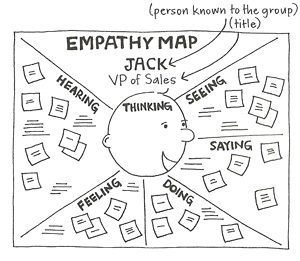 In the world of online marketing, it’s often helpful during the planning process to create detailed personas of your key customer or constituent types. In other words, rather than just relying on demographics (“Our typical customer is a college-educated male who makes $50,000 to $75,000 per year and tends to have entrepreneurial tendencies.”), you drill down lower and actually create a personality for one imaginary person in that customer segment.
In the world of online marketing, it’s often helpful during the planning process to create detailed personas of your key customer or constituent types. In other words, rather than just relying on demographics (“Our typical customer is a college-educated male who makes $50,000 to $75,000 per year and tends to have entrepreneurial tendencies.”), you drill down lower and actually create a personality for one imaginary person in that customer segment.
This approach demands that you dig more deeply into how he or she thinks, what’s important to him or her and what motivates him or her. An empathy map is a perfect tool for capturing this information.
In their excellent new book, Gamestorming: A Playbook for Innovators, Rulebreakers and Changemakers, authors Dave Gray, Sunni Brown and James Macanufo describe how to draw an empathy map:
1. Draw a large circle in the middle of the page, add simple eyes, nose and ear to make it into a human head. Label it “thinking” and give this imaginary person a name.
2. Create large regions around the head labeled seeing, saying, doing, feeling and hearing.
3. Walk through each region, starting with seeing, and describe this person’s experience, from his or her point of view.
The goal of creating such a visual map is to help you and the members of your work group to build up empathy with your core customer group.
The value of empathy mapping
As someone who has developed numerous websites and has studied the principles of web usability quite extensively, I’m very familiar with the concept of creating personas, and why they are critic to crafting excellent user experiences. But I’ve never seen them expressed in this way. I think there is real value in drawing such a map on a whiteboard or flip chart in a small group planning meeting, because it improves the “buy-in” of team members (because they contributed to it) and it acts as a highly visible reminder of whom the team ultimately serves.
How to adapt this technique to mind mapping
Here’s how I would adapt this marvelous visual thinking technique to mind mapping software:
- Place a picture of a typical or actual customer at the center of the map
- Arrange the areas of seeing, saying, doing, feeling and hearing as branches around the central topic – instead of regions.
- Add details to the appropriate branches
Whether you’re doing website design or planning next year’s big marketing campaign, it pays to “get inside the head” of your key customers and prospects. And an empathy map, whether hand drawn or produced within a mind mapping program, is a valuable exercise!

Leave a Reply